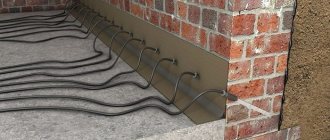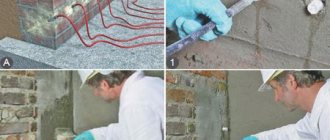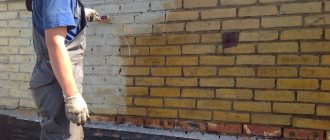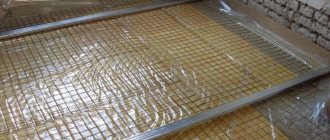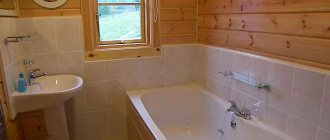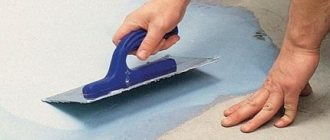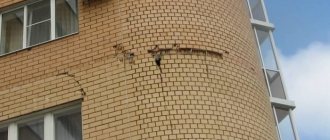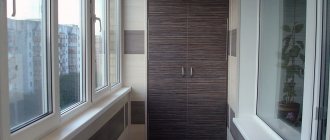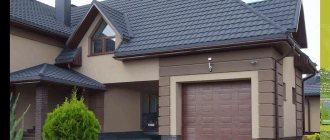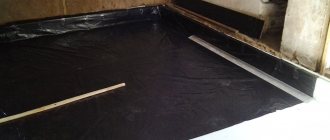Waterproofing walls is a mandatory procedure when constructing a building. Unprotected surfaces will be exposed to moisture - precipitation, condensation - and deteriorate, and mold may appear on them. When carrying out work, it is necessary to strictly adhere to the technology; this is the only way to ensure protection of brick, wooden or concrete surfaces from water, extending the service life of the house.
Application of liquid waterproofing
Sources of moisture
Condensation forms on the internal surfaces of the walls in the room. This occurs due to increased air humidity. In bathrooms, kitchens, basements, non-residential buildings (garage, shed, workshop), especially if they do not have a heating system, air humidity is constantly increased, so protecting the walls from the inside is mandatory.
Another reason for the appearance of condensation is insufficient quality insulation of the house.
External surfaces come into contact with precipitation and groundwater.
Why is waterproofing needed?
The absence of a waterproof coating will significantly reduce the service life of the building; the material (concrete, brick, wood) will deteriorate, cracks, mold, and moss will appear on it. To prevent this from happening, you need to waterproof the walls outside and inside.
In addition, protecting internal surfaces will help:
- prevent the appearance of damp smell;
- maintain an optimal indoor microclimate;
- protect pipes and other metal structures from corrosion;
- delay the need for cosmetic and major repairs.
Waterproofing the facade of a house from various materials
When selecting raw materials, it is necessary to focus on what material the house was built from.
Buildings can be wooden, brick, concrete or made of gas silicate blocks. Is the façade ventilated? In wooden buildings, they use protection from water from special hydrophobic substances, which are applied to the wooden surface in 3-6 layers. When impregnated with the composition, the wood acquires reliable protection from a humid environment, as well as from mold, insect pests and fungus.
In frame houses, special membrane elements are used as waterproofing for facades, which are attached to the walls from the outside and inside using counter-battens.
Brick and concrete elements have a porous structure, for this reason it is recommended to use liquid compounds. To apply the substance to wall surfaces, use brushes or a roller. It is necessary to cover the surface in several layers. The procedure must be performed when there is no rain, when there is no moisture and it is dry. Plaster can be used to waterproof concrete parts.
Aerated concrete elements are treated with plaster or sprayed raw materials.
Types of waterproofing materials
According to their purpose, materials are divided into 4 types:
- sealing;
- anti-corrosion;
- hydro- and heat-insulating;
- antifiltration.
In appearance, waterproofing can be liquid or roll.
An example of using rolled waterproofing
Bitumen mastic
Bitumen is an elastic mass that is a product of oil refining. Creates a dense waterproof film on the surface and is not subject to cracking. Fills the smallest cracks, penetrates into the pores of the base. Used in combination with roll material or independently. Designed to protect the wall from the outside and treat the foundation.
Bitumen mastic is easy to apply; even a person with no experience can cope with the task. The work takes a little time. The material is sold in the form of bars, which must be heated to 150 degrees to melt before use.
The disadvantages include the duration of hardening. If low-quality compounds are used, the resulting coating may crack over time.
Polymer mastic
Polymer mastics are acrylic-based plastic adhesive compositions used for waterproofing walls from the inside or outside. In addition to protection from moisture, it improves the thermal insulation properties of the treated surface.
Advantages of polymer mastic:
- forms a dense, even coating that does not require finishing;
- fireproof;
- protects against moisture, fungus, moss;
- has a safe composition that allows its use in bathrooms and other rooms;
- Available in a wide range of colors;
- resistant to sub-zero temperatures;
- dries quickly;
- elastic, when the base dries or deforms, it retains its integrity.
Colored polymer mastic
Deep penetration compositions
Dry mixtures containing quartz sand, cement and polyurethane resins are diluted with water immediately before use. After drying, they form an airtight film that reliably protects the surface.
The application technology is extremely simple; the work can be performed by a non-specialist. Penetrating compounds are used primarily inside the home.
Roofing felt and roofing felt
Both materials are used to waterproof the outside of the wall and protect the foundation from moisture.
Ruberoid is a rolled material consisting of a base (cardboard, fiberglass) and impregnation (most often bitumen). Roofing felt is a cardboard sheet impregnated with a tar composition. The first is superior to the second in its properties; only it costs less.
Membrane (film)
It is a roll material made of synthetic rubber or PVC. Used indoors and outdoors. A significant drawback is instability to mechanical stress. Waterproofing film for walls can easily be damaged during installation.
Covering the foundation wall with a membrane
Injection waterproofing
This type includes:
- epoxy compounds;
- acrylate gels;
- polyurethane compounds.
Holes are drilled in the wall in increments of 50 cm into which liquid is injected under high pressure. The method is quite expensive and requires special equipment, so its use is justified only in very complex cases when it is impossible to use other materials.
Typical mistakes when installing waterproofing in an apartment
Waterproofing is laid only on the floor
– moisture protection also needs to be installed on the walls to a height of 10 cm around the entire perimeter of the room. It is especially important to comply with these standards in the bathroom, where the moisture-soaked floor creates ideal conditions for mold fungi.
Kitchen without waterproofing
– The faucet, pipes or dishwasher may leak. The concrete is destroyed and moisture seeps into the neighbors below.
Waterproofing on uneven floors
– material laid on an uneven dusty surface with cracks or chips will “lag behind”, lose its characteristics and allow moisture to pass through.
It happens that there is no waterproofing at all, including in apartments, because the builders decided to save on materials.
Location of insulation cover
Waterproofing a wall can be done in 2 ways: horizontal and vertical.
Vertical
This method is used both during the construction process and during renovation work. Use roll or liquid waterproofing material or both at the same time.
Horizontal
The rolled material is laid on the base where the wall is being built. Roofing material or film will prevent the absorption of moisture from the cellar, basement or soil.
Horizontal waterproofing
Installation of horizontal waterproofing is possible only at the construction stage.
Methods for protecting buildings from moisture
Waterproofing methods for civil and industrial buildings are classified according to the technology of application to the surface. You need to choose the most suitable method.
The following methods are distinguished:
- gluing;
- painting;
- lubricant;
- plaster;
- penetration;
- impregnation and other methods.
Having tested various waterproofing methods, experts recommend impregnating surfaces exposed to moisture.
Internal protection
Waterproofing of internal walls is carried out using polymer mastics or fixing the membrane.
Procedure for applying mastic:
- The prepared and cleaned surface is leveled with cement plaster.
- Apply primer.
- After drying, the surfaces are covered with a layer of waterproofing. In total, several layers will be required.
Polymer films are used for walls in an apartment or private house. Membrane installation:
- The sheathing is attached to the insulated surface.
- Insulation is placed in the cells between the racks.
- Using slats, the film is attached to the frame. Place it vertically, the stripes overlap.
- The cladding is carried out with finishing material.
If necessary, you can attach 2 layers of film - directly to the wall, before installing the sheathing, then to the frame itself.
Protection from moisture in a brick house
It is not surprising that brick buildings must be protected from moisture, and the sooner this is done, the better, since the brick immediately begins to absorb moisture from the environment. The waterproof layer, which protects the surface of walls and ceilings, is usually applied externally, but in some cases an integrated approach is used where waterproofing materials are used both internally and externally .
The highest quality and most effective option for insulation builders is a penetrating mixture, which is used from the accessible side. These impregnations applied to external walls completely prevent moisture, creating an excellent water lock that is resistant to damage.
Preparing a brick wall before applying impregnation involves thoroughly cleaning it from dirt and dust, leveling the surface and repairing areas. If cracks are found in the masonry, they must be closed. To perform the work you need a protective suit, gloves and a mask.
A primer is applied to the surface for better adhesion , after which a waterproofing composition is applied to the moistened surface. You can use a brush or roller for this. Typically, the penetrating mixture is applied in several layers - to find out the number, read the instructions. Please note that already at the purchase stage you must select a specific composition designed for your type of wall.
When carrying out waterproofing work in a high-rise building, pay special attention to air joints. If we are talking about a private house, then you will have to work a lot: partially dig the foundation, clear it of soil and apply a special primer, as well as waterproof the bitumen. Sometimes roll materials are used, which strengthen the waterproofing material. Experts recommend planning for insulation early in construction.
Features of waterproofing foundations and basement walls
The main feature of the foundation waterproofing process is that the surfaces requiring treatment are buried in the soil, and they will need to be cleared by digging a trench around the perimeter of the building.
Before starting work, you need to inspect the foundation and eliminate all defects.
Waterproofing of basement walls from the inside is carried out using bitumen mastic, roofing felt, and membrane.
Waterproofing a basement wall
How to make a hydraulic seal?
Titovite Member of FORUMHOUSE
Given: reinforced concrete M350 basement wall 30 cm thick. Apart from the basement with the ceiling, nothing was built. Waterproofing done. In the fall, at a level of -1.70 from the planning ground level, a leak occurred along a threaded rod (they remained in the concrete and served as a tie for sheets of plywood formwork). Most likely, rainwater is flowing under the waterproofing from above. When there is a house, this problem should disappear. I'm thinking about how to fix the leak now.
Thoughts like this:
- Hollow out the concrete in a circle around the stud to a depth of 10 cm.
- Cut off the stud by welding.
- Dust off and prime the resulting “crater”.
- Apply a hydraulic seal.
But the question is what to make it from. I think from a mixture of Portland cement, tile adhesive and liquid glass to the desired thickness. But maybe there are other proven recipes that are more effective?
Answer from a GLIMS expert.
— Your thoughts on the work execution system are correct, but may be temporary. Let's go in order:
- Hollowing out concrete to a depth of 10 cm is overkill; 3 cm (30 mm) is enough.
- Cut off the pin.
- Dust off and prime - in your case, priming is not only not necessary, but is more harmful than useful. Since you have M350 concrete, it is a high-strength concrete with a low degree of absorption. If you also prime it, you will further reduce absorbency. It is enough to saturate the concrete base with water and it will be better than priming.
- You don’t need to invent a hydraulic seal yourself - we did it many years ago. Our cement water seal is perfect for you - just for eliminating direct water leaks and sealing holes. You can even work underwater!
Question about waterproofing (waterproofing) that is done on the foundation - if water flows along the stud, it means that the external waterproofing has already been damaged. Having sealed one stud and blocking the ability of water to pass through, without solving the problem, the water will look for another place to exit and perhaps it will be a neighboring stud.
To check the quality of waterproofing on the foundation, block the access to rainwater from above. For example, cover your foundation with a durable film around the perimeter so that water cannot only flow in from above. In this way, we will understand where the water comes from - rain or groundwater.
Waterproofing of external walls
To protect external surfaces, you can use bitumen, roofing felt, or a combination of both.
Coating technology
Procedure:
- Cleaned surfaces are primed with a special composition (you can use bitumen diluted with gasoline). Apply the liquid with a brush. Wait until it dries. Apply a second layer.
- Cover with bitumen mastic preheated to a liquid state. If the composition is too thick and difficult to spread, add a small amount of solvent or gasoline to obtain the desired consistency. Particular attention is paid to the joints of the material from which the foundation is made.
- After applying the first layer, wait until it hardens. Cover with another one.
In order for waterproofing to perform its intended function, its total thickness must be at least 3 mm.
Pasting principle
Waterproofing the external walls of a house with rolled material is carried out as follows:
- The cleared surfaces are primed in 2 layers.
- Heat a strip of roofing felt or roofing felt using a hair dryer or burner. The impregnation needs to soften.
- Apply the material to the bottom edge of the surface horizontally (parallel to the ground).
- Press with force and carefully iron so that the roofing felt sticks tightly to the outer wall and there is no air left inside.
- The next strip is fixed vertically, with its lower end touching a horizontally fixed section of roofing material. The remaining strips are fixed in the same way, making an overlap of about 20 cm.
- The joints must be additionally sealed. Bitumen mastic is suitable for this.
Combined method
Waterproofing an external wall with roofing felt
For high-quality and reliable waterproofing of the walls of a house, you can use a liquid composition and rolled material.
In this case, first the surface is coated with bitumen mastic, and roofing material is laid on it.
The simplicity of the technology and the absence of the need to use special equipment make it possible to carry out work on protecting walls from moisture with your own hands, and the tangible benefits - a significant increase in the service life of the building - justify the investment of time and money.
Coating technology
Coating-type waterproofing compounds are used to treat the internal and external surfaces of a building. They prevent capillary moisture from affecting the walls. If there is a hydraulic barrier with a pressure of up to 2 meters, the use of protection is possible under certain conditions:
- there should be no expansion joints on the walls;
- subsequently it will be possible to carry out repair work.
External waterproofing of walls involves the use of bitumen mastics, which are applied on the side most exposed to moisture.
Coating-type compositions are applied in 2-4 layers.
Application
Having found out what coating waterproofing is, let’s consider the technique of its use using the example of treating the external walls of a brick building with a concrete foundation.
First you need to dig up the walls of the building’s base and free them from the remains of the earth.
After this, the surfaces are treated with a special primer mixture or construction bitumen dissolved in gasoline (primer). This composition is applied with a brush or roller in two layers. The walls are allowed to dry completely. Then the surface is treated with mastic.
What to do if the material is too viscous? Gasoline or thinner will help dilute it. The seams of concrete blocks are carefully processed.
Bitumen waterproofing of walls must have a thickness of at least 3 mm. The product is used 2-3 times, allowing each layer to dry before applying the next one.
